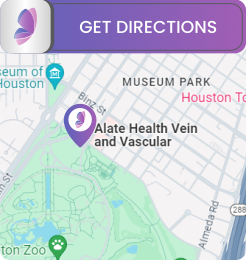Leg Ulcers Treatment Specialist in Houston, TX
Leg ulcers are persistent, open sores on the legs, causing pain, swelling, and skin changes. Common symptoms include discoloration, hardening, or itching. Caused by poor circulation, vein problems, or diabetes, seeking help is crucial for alleviating discomfort and improving quality of life. Dr. Andrew Doe, MD, at Alate Health Interventional Radiology Clinic, provide treatment for Leg ulcers. For more information, contact us today or book an appointment online. We are conveniently located at 1213 Hermann Dr Suite 255, Houston, TX 77004.


Table of Contents:
What is a leg ulcer?
What causes leg ulcers?
What are the types of leg ulcers?
What is the difference between a venous ulcer and a leg ulcer?
How long do leg ulcers take to heal?
Leg ulcers are long-lasting sores that usually take four to six weeks to heal. These ulcers often develop just above the ankle when the skin and underlying tissue break down and fail to heal due to various factors, such as poor circulation, nerve damage, or persistent pressure.
Some of the most common symptoms of leg ulcers include:
– Persistent discomfort in the affected area.
– Itching and irritation.
– Swelling and redness.
– Changes in skin color around the wound.
– A foul odor from the wound.
– Discharge or pus.
If you notice symptoms of a leg ulcer, it’s essential to consult a reputable healthcare provider to determine if an ulcer or another condition is behind your discomfort.
Leg ulcers can occur as a result of various underlying conditions, such as:
Venous insufficiency: When the veins in the legs are unable to return blood to the heart efficiently, the pressure in these blood vessels increases, which can lead to damage. Over time, this pressure causes the skin to break down, resulting in ulcer formation.
Diabetes: As this condition leads to poor circulation and nerve damage, diabetic leg ulcers are common. Additionally, high blood sugar levels can further impair immune function and healing.
Arterial disease: Arterial disease is the underlying cause of arterial leg ulcers. As a result of this condition, reduced blood flow deprives the tissues of nutrients and oxygen, causing the formation of leg ulcers.
Some of the other risk factors for leg ulcers include infection, high blood pressure, obesity, injury, smoking, immobility, and autoimmune conditions.
Some of the most common types of leg ulcers are:
Venous leg ulcers: When the valves of the veins in the leg do not function properly, circulation is compromised, and venous leg ulcers may develop.
Arterial leg ulcers: The narrowing of the arteries can cause poor blood flow and result in severe pain, especially at night.
Vasculitis ulcers: These ulcers are linked to chronic inflammatory conditions like lupus or rheumatoid arthritis.
Diabetic leg ulcers: Patients with diabetes are prone to leg ulcers due to nerve damage, poor circulation, and impaired healing.
Pressure ulcers: Prolonged pressure on the skin may cause pressure ulcers to occur. This type of leg ulcer is common in patients prescribed bed rest.
While “leg ulcer” is a general term that medical professionals use to refer to chronic sores on the legs, a venous ulcer is a more specific term, referring to a particular type of leg ulcer. As one of the most common types of leg ulcers, venous ulcers are linked with venous insufficiency, varicose veins, and prolonged sitting or standing. Poor blood flow in the veins leads to increased pressure on the blood vessels, resulting in skin breakdown and the development of ulcers. If you have venous insufficiency or suspect you have a venous ulcer, it’s urged that you see a specialist for treatment.
The healing time for leg ulcers depends on several factors, such as the type of ulcer, its severity, and the promptness and effectiveness of treatment. With appropriate treatment, such as compression therapy, venous ulcers typically take around 3 to 4 months to heal. However, some may take longer, especially if there are complications or if the patient has other health problems.
Arterial ulcers may take longer to heal due to reduced blood flow. Your doctor will recommend treatment options to improve circulation, such as lifestyle changes and medications. Diabetic ulcers can be particularly challenging to heal due to poor circulation and nerve damage. With diligent care, including blood sugar management, appropriate wound care, and possibly surgical intervention, healing can take several weeks to months.
If you have leg ulcers, it’s crucial not to delay treatment. The dedicated team at Alate Health in Houston can evaluate your symptoms, accurately pinpoint what’s causing your discomfort, and provide you with treatment options to promote a swift recovery. For more information, contact us today or book an appointment online. We are conveniently located at 1213 Hermann Dr Suite 255, Houston, TX 77004. We serve patients from Houston TX, Bellaire TX, Jacinto City TX, Spring Valley Village TX, Stafford TX, Bunker Hill Village TX, and surrounding cities.

Additional Services You May Need
▸ Adenomyosis
▸ Enlarged Prostate
▸ Leg Ulcers
▸ Joint Pain
▸ Varicose Veins
▸ Uterine Fibroids
▸ Pelvic Congestion
▸ Vascular Malformations
▸ Dialysis/Renal Failure
▸ Port and PICC Placements
▸ Peripheral Arterial Disease
▸ Primary and Metastatic Liver Cancers
▸ Hemorrhoid Artery Embolization (HAE)







